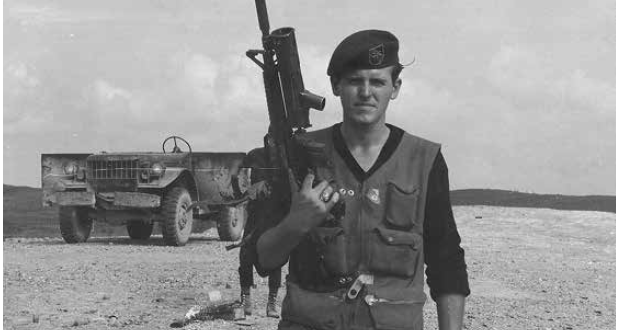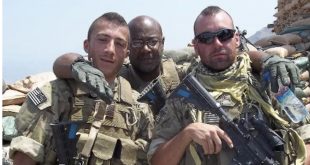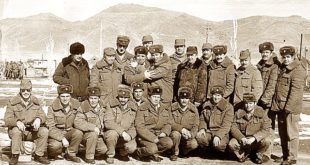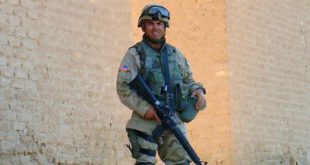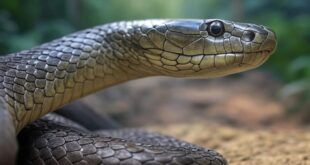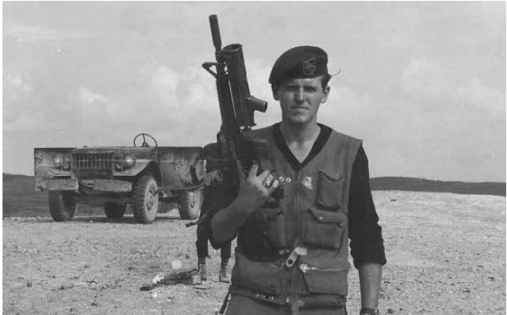

NVA General to SOG Recon Team: We suffered 90 percent casualties
By Tilt Stryker Meyer
SOF.Black.Part 2
Before ST Alabama could celebrate, the NVA charged again. Three more dead NVA were added to the cadaver wall.
Silence dominated the battlefield. No bird chirps, no speaking, no noise of any type. Even the aircraft over the scene had flown far enough away that their absence amplified the empty air. The One-One, who hadn’t fired a single shot, continued to pray.
Black patched up a bleeding Cowboy. He gave some him morphine before bandaging a wound on his right side from an AK-47 bullet wound.
“Where’s John Wayne when you need him?” Cowboy asked. The others laughed.
“Chieu Hoi, du maa(Give up, motherfuckers)!” an enemy soldier yelled. Another NVA told Black to “Chieu Hoi” in English. Black flipped him the bird as a sniper shot Alabama’s tail gunner, Cuong, in the crotch, hitting an artery.
As Tho applied direct pressure to Cuong’s wound, an A-1H Skyraider lumbered into the AO. Flown by a pilot code-named “Snoopy,” he roared in from Black’s left, brushing the treetops, full flaps, working his throttle. The aircraft was so close to the team that Black could hear the distinctive, metallic click-click of the napalm canisters being released from the old Korean War era plane. The Skyraider appeared to be falling, but actually it slipped down into the valley to escape NVA gunfire, as the Americal UH-1B Muskets’ gunships and fast movers had maneuvered earlier in the day.
His wingman appeared and as he flew over the team they could hear the nuts and bolts and God knows what creaking and groaning as he salvoed the rockets. The NVA were pissed. Again, the hot shell casings from the airborne warships rained down on ST Alabama.
Then three small mortars opened fire. Black knew there was no way in hell any of the team could catch mortars and throw them back. He and the Vietnamese team leader, Tho, rolled over the cadaver wall toward the mortars, cautiously picking their way through the charred NVA bodies and carnage from the previous airborne assaults. They moved into the jungle, within 20 feet of the first mortar tube. Tho drew a plan in the ground. He would hit tube one, Black would hit tube three and they’d combine on tube two.
After the mortarmen launched three salvos, Tho opened fire on his target while Black attacked his targeted tube and several nearby NVA soldiers.
The survivors chased Black. In the confusion, the NVA opened fire on each other as Black headed toward tube one – with NVA soldiers still chasing him – where Tho was pinned down. Black threw a hand grenade and killed at least three NVA with a blast of gunfire to free Tho. They turned on the NVA chasing Black and dealt with them. Then he and Tho wiped out the NVA at the second tube before they quickly returned to the team, all the while picking up ammo and loaded AK-47 magazines from dead or wounded NVA soldiers.
By now, Watkins had returned to flying Covey rider above ST Alabama. Spider had called the U.S. Air Force’s 37thAir Rescue and Recovery Group in Da Nang to attempt a rescue of ST Alabama. During the Vietnam War, when pilots were shot down in North Vietnam or Laos, and all else failed, the Jolly Green Giants of the 37thAir Rescue and Recovery Group were called. The Sikorsky HH-3E weighed 22,050 pounds loaded, had two General Electric T58-GE-5 turboshaft 1,500-hp engines, extra armament and firepower, and they were manned by remarkable Air Force pilots and crews.
The first heavily armored Jolly Green Giant HH-3E, code-named JG 28, started its descent to the LZ from 4,000 feet. As it approached, the JG 28 crew was looking for an orange panel on the southeast side of the LZ. However, as the aircraft was about to touch down, crewmembers noticed a second panel. The NVA had an identical panel. The momentary pause was nearly fatal for JG 28, as the NVA opened fire on it from several sides. The heavy gunfire severed the main fuel line, causing a massive fuel leak inside the HH-3E.
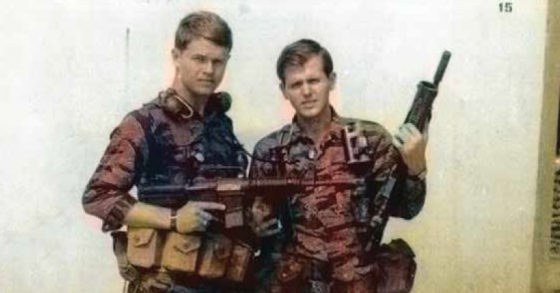
JG 28 had to withdraw from the LZ. In a matter of seconds, there were two to three inches of aviation fuel on the aircraft’s cabin floor. The fumes temporarily blinded the crewmembers. The pilot was able to stabilize the rugged HH-3E and returned to Da Nang, escorted by SPAD 11.
As JG 10 hovered a safe distance away from the LZ, Watkins directed a few more air strikes around ST Alabama, with the hope that the communist soldiers would put their heads down long enough to get the team out.
After a few air strikes, JG 10, piloted by Air Force Major Vernon R. “Sam” Granier, was called to attempt the extraction. For Granier, this was his first assignment in the Prairie Fire AO as a Jolly Green Giant pilot.
When the call from Covey came, Granier knew that there were two U.S. Green Berets on the ground with their Vietnamese team members and that the majority of the team was wounded. He didn’t hesitate. Granier piloted the Jolly Green Giant toward the LZ. Unlike JG 28, Granier knew which side of the LZ ST Alabama was on. As he approached the LZ, NVA gunfire again reached a deafening roar, despite ST Alabama directing firepower at the communist soldiers.
As Granier began to hover over the LZ, JG 10 was hammered by enemy gunfire. His crew chief reported that one NVA round had torn a six-inch hole through the floor. The round apparently slammed into one of the engines. Both engine-warning lights went on. Both engines were on fire.
Granier did a 180-degree turn and moved the damaged aircraft away from the deadly enemy fire, away from the team, struggling to keep it airborne, calling upon all of the training he had received to continue flying. Both crewmembers continued firing their machine guns as Granier battled to keep the ship in the air.
Time ran out for JG 10. After traveling several hundred yards, Granier warned his crew to brace themselves for a crash landing. Both crewmembers continued firing their weapons until the burning HH-3E slammed into the jungle.
ST Alabama was stunned. Covey and all of the men flying over the target area viewed the horror in grim silence.
The men back at FOB 1 monitored the radio transmissions on their PRC-25s FM radioes as Covey talked to Black. Spike Team Alabama’s radio signal was too weak to hear any response. The word spread through camp about the latest horrific turn of events surrounding ST Alabama. The usual hustle/bustle of a Saturday at FOB 1 was replaced by quiet, hushed tones as the entire compound feared the worst, but continued to pray for the men of ST Alabama. Word of a proposed Arc Light mission reinforced the gravity of ST Alabama’s situation. An Arc Light was a strike by a B-52 bomber from more than 25,000 feet.
Back in Laos, the stunned members of ST Alabama returned to their cadaver perimeter once again, nearly out of ammo. One-One was face down, muttering, “The Lord is my shepherd…” One of the Vietnamese went about collecting AK-47s and ammo from the dead NVA as Spider and Watkins directed more air strikes around the team.
Within 10 to 15 minutes after Granier’s burning HH-3E crashed into the jungle, Covey learned that there were two survivors from the Jolly Green Giant and asked ST Alabama if they could locate the remaining crewmembers. Granier had broken his back, but somehow had pulled himself from the burning HH-3E. The other Jolly Green Giant survivor, Sergeant Earnest Dean Casbeer, had been thrown clear of the crash. Neither knew the location of the other.
Watkins told Black where the Air Force survivors were and that they’d run a daisy chain between his position and the men, hopefully to clear the area enough for the team to get to both of the survivors.
The NVA threw one more curve at ST Alabama. When Black tried to talk to Covey, he found the primary, secondary and alternate FM frequencies jammed by the NVA. Frustrated, Black smashed the PRC-25 and pulled out his URC-10 ultra-high frequency survival radio. He was told that an Arc Light strike was being planned for this area as soon as possible.
By now all the air assets, Navy, Marine and Air Force, which had been scheduled to fly sorties into North Vietnam, were diverted to the Prairie Fire Emergency surrounding ST Alabama.
Covey directed numerous air strikes, including more gun and rocket runs from helicopter gunships. Scarface, the Hueys from the Marine Light Helicopter Squadron 367, returned to make several runs. After refueling and reloading in Phu Bai, the Minute Men Muskets returned to wreak havoc on the persistent NVA troops. They pounded the jungle area between ST Alabama and the Air Force survivors as part of the daisy chain tactic.
Jolly Green Giant Hovers in Jungle
Around 1800 hours, a Jolly Green pilot, Air Force Major Don Olsen, called over the radio, “Blackjack, JG 32, over. I’m parked down in the draw, in the trees from you. You have 20 minutes of fuel before I leave…the first person we MUST see is an American…Hurry! We’re taking heavy ground fire.”
Anything that couldn’t be carried was thrown over the side of the cliff. As quickly as the wounded could move, they headed toward the Jolly Green Giant. The chopper had literally cut away treetops and branches to nestle into the thick dark green foliage, thus reducing its profile to enemy gunners.Olsen had to keep the aircraft stable as there were large trees on all sides of the aircraft. The trees were large enough that they could severely damage the five rotor blades and cause the chopper to crash if he hit any of them.
Covey directed more air strikes in a daisy chain fashion in the portion of the jungle between ST Alabama and the hovering Jolly Green Giant. Watkins hoped this would drive out or kill the NVA in the zone. Even that task became more difficult, as smoke from all of the expended ordnance continued to hang above the trees, decreasing the visibility for pilots and helicopter gunners.
As they moved toward the hovering HH-3E, ST Alabama entered a cool ravine before climbing the final hill to the chopper. There they encountered a village with hooches built on 10-foot stilts, complete with large pots cooking rice and vegetables. Instead of NVA troops, Black found an American taking food from one of the pots. He was the Flight Engineer, Sergeant Earnest Dean Casbeer, one of the two Air Force survivors from the crashed HH-3E. Soon they found Granier.
The NVA focused heavily on the chopper, easing the pressure on ST Alabama. As the beleaguered recon team neared the Jolly Green, Black thought it felt like they were moving closer to the gates of hell itself. The NVA were pouring small arms fire and RPGs at the hovering ship while the door gunners and pilots intermittently fired the mini-gun, M-79s and M-60s, while helicopter gunships and Skyraiders made gun runs around it.
Time was against them. The weather began to close in. The smoke from previous air strikes hung over the area for longer and longer periods of time before clearing enough for the next attack from the air.
On the ground, the men of ST Alabama heard NVA running through the bushes around them. Fortunately the NVA failed to spot the spike team or the Air Force crewmen. Desperate, Black had to move his team onto a trail so it could move to the hovering HH-3E more quickly. As the team moved up the trail, the tail gunner was shaking violently and had turned a pasty white. Team members set Cuong down and proceeded to the aircraft. At the crest of the trail, they saw the HH-3E taking hits and dealing out its own; its M-60 was red hot. Black saw someone firing an M-16 out of one of the windows.
As Black moved to the chopper, the intensity of gunfire seemed to multiply. The air was so full of lead he could see it. Fuel and bits of metal skin fell from the aircraft as they reached its underside.
The jungle penetrator smashed to the ground next to him and raised three feet before he put three team members on the first load. Granier, the Air Force Flight Engineer and a wounded ST Alabama team member were on the second hoist lift. The wounded Vietnamese became entangled in jungle vines while he was being hoisted upwards. The Air Force hoist operator had to stop the hoist, lower it and give him time to untangle himself. When the hoist moved up toward the aircraft, the Vietnamese was not sitting in the seat, but hanging on, with assistance from Air Force Sergeant Casbeer.
Despite the NVA gunfire, Black ran back to the bamboo thicket where he had left the remainder of the team. Cuong, the dying tail gunner, pointed his .45 cal. pistol at the advancing NVA and said, “Toi kiet(I die).” He motioned Black to return to the HH-3E before shooting himself.
Black was running back to the ship when two NVA stepped onto the trail and pointed their AK-47s at him.
“Chieu hoi!” one of the soldiers shouted. Black stretched out his arms and continued walking toward them.
When he was only a few feet away, he said, “Chieu hoi!” The young NVA soldiers appeared surprised. Before they could react, Black grabbed the AK-47s by their searing barrels and stripped them from the soldiers. He backhanded the soldier on his right and smashed the other soldier in the face with one of the weapons.
He left the stunned soldiers lying there as he sprinted to the chopper, where he found the praying One-One. The rest of the team was on board, firing any weapon they could get their hands on. As the jungle penetrator lifted Black and the One-One upward, they were showered with hot spent casings from the M-60 and other weapons being fired from inside the aircraft.
The entire team fired out the windows and from the back door as the overloaded HH-3E began to lift out of the jungle. Major Olsen told Covey he was at maximum power.
Rockets Slam into Chopper
As the Jolly Green Giant slowly rose, Black felt the ship making upward surges from the B-40 rockets slamming into the armor-plated underside of the aircraft. It felt like a giant slugging the ship in the stomach, boosting it upward with each rocket blast. From his view above the fray, Watkins couldn’t believe the bird kept flying. Somehow the pilot got the Jolly Green out of there.
Once clear of the jungle hole, the ship began its ascent out of the valley and the shadow of death. The door gunner removed his helmet and placed it on Black’s head. The pilot told him, “We’re on our way home.” Not quite.
From above, Watkins saw the crippled ship catch fire and try to make it out of the killing zone. It crossed two ridgelines before descending into a clearing where it crash-landed. Olsen had gotten them out of the killing zone, but JG 32 had flown its last rescue mission. Everyone except Black and the One-One were transferred to another Jolly Green Giant, piloted by a Coast Guard exchange pilot, Lieutenant Commander Lonnie Mixon. Mixon took over 30 hits picking up ST Alabama and the Air Force survivors.
A Cobra gunship landed and opened the armament compartment doors, which had seatbelts attached to them. Black and the One-One buckled up and were soon airborne alongside the Jolly Green Giant, returning to Da Nang. They were flying so fast that Black had to turn his bloodstained face away in order to breathe. Within minutes, he was so cold he was shivering uncontrollably. The Cobra landed at a Marine medevac site, where the Americans were wrapped in poncho liners and helicoptered to Da Nang.
After Watkins knew that Black, the remaining personnel from ST Alabama, and the Air Force survivors from JG 10 were cleared from the original target area, they hammered it with everything they had, including more napalm, bombs and gun runs. Captain Hartness, the pilot of Watkin’s FAC plane, was so mad that he flew the 0-2 down into small arms fire range and fired 2.75inch rockets into the area where the NVA had knocked down JG 10. He and Watkins took a hit to the front and the engine died. Hartness somehow got the Skymaster 0-2 up, out of the area and back to Phu Bai. There was no engine pressure when he landed.
Meanwhile, bact at the Da Nang infirmary, everyone was getting patched up. When Tho saw Black, he raised his right hand in a fist above his head.
“CHIEU HOI, DU MAA!” he yelled. The One-One, who was not wounded, stood up on a chair.
“Listen up, men! I want to commend each and every one of you for a job well done. As the team leader of ST Alabama, I want you to know I personally am going to put each of you in for the Medal of Honor. You medics take care of my people.” He stepped down and left the room. The wounded, exhausted members of ST Alabama looked at Black, aghast.
Black couldn’t believe what he had heard the One-One say, but because Alabama was his team and since they were in another unit’s facility, he wouldn’t do anything that would reflect poorly on the entire team. That night, Black was so mad he knocked the pills out of the medic’s hand and instead of lying down for treatment, he went with a Jolly Green medic to his Air Force barracks for a show. There, the medic applied bandages and compresses to the numerous bleeding abrasions and shrapnel holes in his chest, back, arms and legs, and to the burns on his hands from the AK-47s.
“So That Others May Live”
While walking to the club, they passed a line of parked Jolly Greens. “So That Others May Live” was printed on the side of one HH-3E. Indeed, two members of the U.S. Air Force’s 3rdAir Rescue and Recovery Group in Da Nang had paid the ultimate price while attempting to extract ST Alabama from Laos. That Air Force slogan had a profound impact on Black, the ST Alabama survivors were alive thanks to the Jolly Green Giants and the heavy price their men paid that day. Not far from Black, HH-3E pilot Granier was being treated for his broken back.
When they entered the club, every man present rose and started clapping. Everyone crowded in and started shaking hands and slapping Black on the back. The pain was excruciating, but Black thought about how a few hours earlier when ST Alabama was fighting for its life. Now he was in a club with men lined up to buy him drinks. The pain was bearable.
The clock said 2200 hours. At Phu Bai, a subdued gathering in the club celebrated ST Alabama’s survival and quietly chalked up the deaths of several good Vietnamese team members to poor leadership. Little was said about the arrogant, dead One-Zero. Recon members talked to Watkins and Spider, looking for lessons learned during that long day. Both of them concurred on at least one point; Lynne Black was the reason that the team came home. When the Covey riders had made recommendations, he listened. It hadn’t been easy, but he didn’t argue; he didn’t challenge. He listened. Both Spider and Watkins also agreed that without Black’s leadership and heroic effort that day, the prospects of anyone on ST Alabama surviving that hellhole had been bleak.
Black and the medics drank until dawn of 6 October 1968. They recounted the story to all who asked and to those who didn’t, but were within earshot. Black finally lay down on a cot in the medic’s room. A medic told him about the Jolly Green crewmember Greg Lawrence that died in the earlier rescue attempts. Black was lying on his cot.
Back in Phu Bai, Black learned that ST Idaho had been inserted into target E-4 early that morning to search for an American POW camp, which was a few klicks from ST Alabama’s target. The secret war in Laos marched on.
* * *
Thirty-one years later, Black cooperated with U.S. Government teams searching for the remains of SOG members and all pilots and aircrews who crashed in the Prairie Fire Area of Operation. He assisted the search team trying to pinpoint where the Special Forces sergeant’s remains were located.
A few months after the unsuccessful effort, Black received a phone call from a man who identified himself as an NVA general. He said he was the colonel who led the first 50 NVA troops into battle from the long side of the L-shaped ambush, atop the rise, which was on Black’s right side on 5 October 1968. The NVA general said he had given the order that triggered the deadly ambush.
“We had an honest discussion about that day,” said Black. “The general told me that when they heard the Kingbees come in, he assembled 50 men and set up the ambush along that trail. He asked me who the American was on the recon team who didn’t lie down on the ground during the ambush. He told me that the man standing had the radio on his back. I told him that it was me; I was the radio operator. Then he said, ‘You shot me three times that day.’”
Black explained that he remembered shooting single shots into the NVA soldiers who stood to his right, firing on ST Alabama. “When he told me that, I remembered that I had shot a few of them more than once. I remember spinning them around when I shot them. Apparently, he was one of them.
“Then he told me, ‘The worst thing about having you shoot me was the fact that I was lying there, watching you kill my men, and there was nothing I could do about it.’”
Black said he and the NVA general chatted a few more minutes about the events of that fateful day in the A Shau Valley. Black mentioned that the NVA had inflicted heavy casualties on ST Alabama, killing three team members and wounding five of the remaining six survivors. “The NVA general told me that his unit had suffered 90 percent casualties that day.”
The general explained to Black the NVA were killed or wounded either in direct combat with ST Alabama or from the numerous air strikes that Black and Covey directed around ST Alabama the entire day and after the Jolly Green Giant lifted clear of the jungle.
Black then told the general that when he observed the NVA flag flying in the middle of the knoll, he assumed that the intelligence estimates of an NVA battalion of approximately 3,000 troops was accurate. The general’s response ensured ST Alabama’s place in SOG history.
“No,” the general corrected Black, “It was a division. We had about 10,000 soldiers of the Army of North Vietnam there that day.”
 Soldier of Fortune Magazine The Journal of Professional Adventurers
Soldier of Fortune Magazine The Journal of Professional Adventurers


